-

人教版高中数学选修3离散型随机变量及其分布列(2)教学设计
温故知新 1.离散型随机变量的定义可能取值为有限个或可以一一列举的随机变量,我们称为离散型随机变量.通常用大写英文字母表示随机变量,例如X,Y,Z;用小写英文字母表示随机变量的取值,例如x,y,z.随机变量的特点: 试验之前可以判断其可能出现的所有值,在试验之前不可能确定取何值;可以用数字表示2、随机变量的分类①离散型随机变量:X的取值可一、一列出;②连续型随机变量:X可以取某个区间内的一切值随机变量将随机事件的结果数量化.3、古典概型:①试验中所有可能出现的基本事件只有有限个;②每个基本事件出现的可能性相等。二、探究新知探究1.抛掷一枚骰子,所得的点数X有哪些值?取每个值的概率是多少? 因为X取值范围是{1,2,3,4,5,6}而且"P(X=m)"=1/6,m=1,2,3,4,5,6.因此X分布列如下表所示
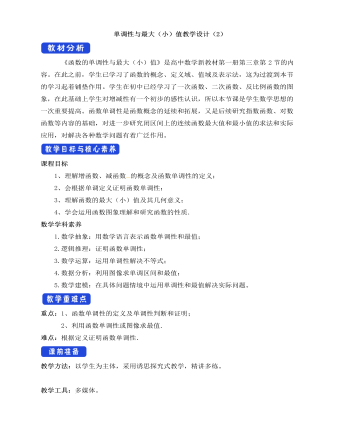
人教A版高中数学必修一单调性与最大(小)值教学设计(2)
《函数的单调性与最大(小)值》是高中数学新教材第一册第三章第2节的内容。在此之前,学生已学习了函数的概念、定义域、值域及表示法,这为过渡到本节的学习起着铺垫作用。学生在初中已经学习了一次函数、二次函数、反比例函数的图象,在此基础上学生对增减性有一个初步的感性认识,所以本节课是学生数学思想的一次重要提高。函数单调性是函数概念的延续和拓展,又是后续研究指数函数、对数函数等内容的基础,对进一步研究闭区间上的连续函数最大值和最小值的求法和实际应用,对解决各种数学问题有着广泛作用。课程目标1、理解增函数、减函数 的概念及函数单调性的定义;2、会根据单调定义证明函数单调性;3、理解函数的最大(小)值及其几何意义;4、学会运用函数图象理解和研究函数的性质.数学学科素养

新人教版高中英语必修3Unit 2 Morals and Virtues-Discovering Useful Structure教学设计
1. 表示时间。Hearing these stories, I’m skeptical about the place. = When I heard these stories. . . 2. 表示原因。Not knowing his address, I can’t send this book to him. = Because/Since/As I don’t know his address. . . 3. 表示结果。His father died, leaving him a lot of money. =. . . and left him a lot of money4. 表示条件。Going straight down the road, you will find the department store. = If you go straight down the road. . . 5. 表示让步。Being tired, they went on working. =Although they were tired. . . 6. 表示行为方式、伴随情况或补充说明。He lay on the grass, staring at the sky for a long time. =. . . and stared at the sky for a long time注意:非谓语动词作状语时, 如所提供的动词不能和句子中的主语保持一致, 动词-ing形式必须有自己的逻辑主语, 通常由名词或代词来担任, 这就是独立主格结构。The last bus having gone, we had to walk home. (having gone的逻辑主语是the last bus, 而不是we)Weather permitting, the football match will be played on Friday. (permitting的逻辑主语是time, 而不是the football match)Step 7 Practice1. ________(study) hard, you are sure to get first prize. 2. People use plastic in their daily life, _______(leave) large amounts of waste. 3. ________(work) hard at your lessons, you are to succeed. 4. The old man, ____________(work) abroad for twenty years, is on the way back to his motherland. 5. ______________(finish) his homework, he was playing on the playground. Answers: 1. Studying 2. leaving 3. Working 4.having worked 5. Having finishedStep 8 HomeworkFinish the homework on Page 22.
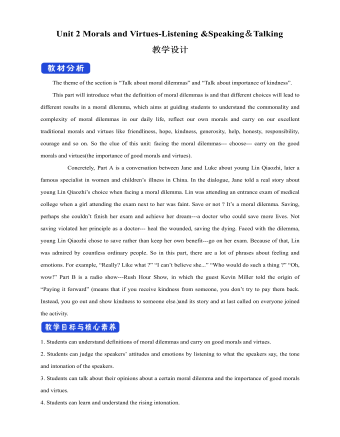
新人教版高中英语必修3Unit 2 Morals and Virtues-Listening &Speaking&Talking教学设计
Example:One day, a poor boy who was trying to pay his way through school by sending newspapers door to door found that he only had one dime(一角)left. He was so hungry that he decided to beg for a meal at the next house.However, he lost his nerve when a lovely young woman opened the door. Instead of a meal he asked for a drink of water. She thought he looked hungry so she brought him a large glass of milk. He drank it slowly, and then asked, “How much do I owe you?” “You don’t owe me anything,” she replied, “Mother has taught me never to accept pay for a kindness.” “Then I thank you from the bottom of my heart.” With these words, Howard Kelly left that house.Years later the woman became badly ill and was finally sent to the hospital in a big city. Dr. Howard Kelly, now famous, was called in. When he heard the name of the town she came from, a strange light filled his eyes. Dressed in his doctor’s clothes, Dr. Kelly went into her room and recognized her at once. From that day on, he gave special attention to her, and decided to do his best to save her life.At last the woman was saved. Dr. Kelly asked the business office to pass the final bill to him. He looked at it and then wrote something on the side. The bill was sent to the woman’s room. She was afraid to open it because she was sure that it would take the rest of her life to pay for it off. Finally she looked, and the note on the side of the bill caught her attention. She read these words: “Paid in full with a glass of milk, Dr. Howard Kelly.” Tear of joy flooded her eyes.
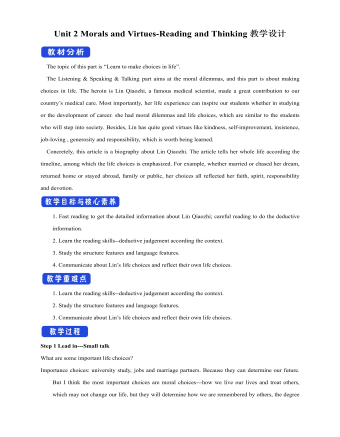
新人教版高中英语必修3Unit 2 Morals and Virtues-Reading and Thinking教学设计
The topic of this part is “Learn to make choices in life”.The Listening & Speaking & Talking part aims at the moral dilemmas, and this part is about making choices in life. The heroin is Lin Qiaozhi, a famous medical scientist, made a great contribution to our country’s medical care. Most importantly, her life experience can inspire our students whether in studying or the development of career. she had moral dilemmas and life choices, which are similar to the students who will step into society. Besides, Lin has quite good virtues like kindness, self-improvement, insistence, job-loving , generosity and responsibility, which is worth being learned.Concretely, this article is a biography about Lin Qiaozhi. The article tells her whole life according the timeline, among which the life choices is emphasized. For example, whether married or chased her dream, returned home or stayed abroad, family or public, her choices all reflected her faith, spirit, responsibility and devotion.1. Fast reading to get the detailed information about Lin Qiaozhi; careful reading to do the deductive information.2. Learn the reading skills--deductive judgement according the context.3. Study the structure features and language features. 4. Communicate about Lin’s life choices and reflect their own life choices.1. Learn the reading skills--deductive judgement according the context.2. Study the structure features and language features.3. Communicate about Lin’s life choices and reflect their own life choices.Step 1 Lead in---Small talkWhat are some important life choices?Importance choices: university study, jobs and marriage partners. Because they can determine our future.
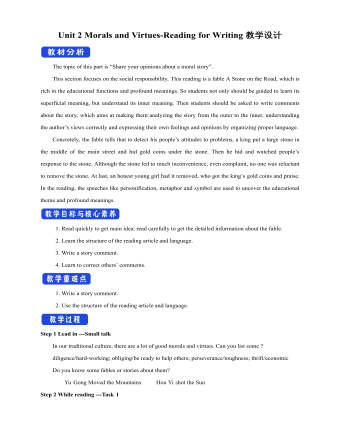
新人教版高中英语必修3Unit 2 Morals and Virtues-Reading for Writing教学设计
1. 这个寓言是一个关于一位国王古寓言。 The fable is an old fable about a king.2.作者用这个故事让读者对于社区的问题负有个人责任的必要印象深刻。The author used the story to impress upon readers with the need to take personal responsibility for problems in the community.3. 这个故事十分成功的实现了它的目的。The story was quite successful in achieving its purpose.Step 7 WritingPlease write a review of the story according the outline above.The fable is an old fable about a king who thought his people are lazy, so he put a large stone in the middle of the road and hides and waited to see if anyone will try to move it.The author used this story to impress upon readers with the need to take personal responsibility for problems in the community. The story was quite successful in achieving its purpose, and I liked it because it had a clear moral.However, while the moral of the story is clear, the actions of the king seemed pointless to me, because none of the characters in the story learnt anything. For this reason, I think there are better stories that can be used to impress upon people with the need for personal responsibility.Step 8 Pair workExchange drafts with a partner. Use this checklist to help your partner revise his/her draft.1. Does the writer give a short description of the story ?2. Does the description include the most important details of the story ?3. Does the writer give his or her opinion about the character or their actions ?4. Is the review well-organised ? 5. Does the writer use the -ing form as the adverbial correctly in the writing ?6. Are there any grammar, spelling, or punctuation errors ?Step 9 HomeworkPut up your revised draft in the classroom or read it to your class.
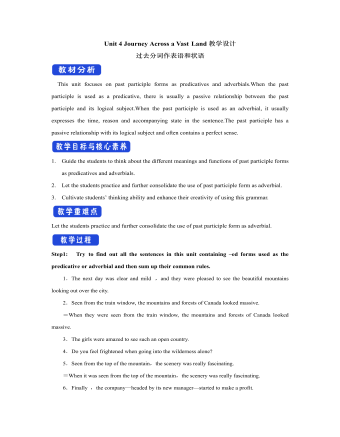
新人教版高中英语选修2Unit 4 Journey Across a Vast Land教学设计
当孩子们由父母陪同时,他们才被允许进入这个运动场。3.过去分词(短语)作状语时的几种特殊情况(1)过去分词(短语)在句中作时间、条件、原因、让步状语时,相当于对应的时间、条件、原因及让步状语从句。Seen from the top of the mountain (=When it is seen from the top of the mountain), the whole town looks more beautiful.从山顶上看,整个城市看起来更美了。Given ten more minutes (=If we are given ten more minutes), we will finish the work perfectly.如果多给十分钟,我们会完美地完成这项工作。Greatly touched by his words (=Because she was greatly touched by his words), she was full of tears.由于被他的话深深地感动,她满眼泪花。Warned of the storm (=Though they were warned of the storm), the farmers were still working on the farm.尽管被警告了风暴的到来,但农民们仍在农场干活。(2)过去分词(短语)在句中作伴随、方式等状语时,可改为句子的并列谓语或改为并列分句。The teacher came into the room, followed by two students (=and was followed by two students).后面跟着两个学生,老师走进了房间。He spent the whole afternoon, accompanied by his mom(=and was accompanied by his mom).他由母亲陪着度过了一整个下午。

新人教版高中英语选修2Unit 3 Food and Culture-Discovering useful structures教学设计
The newspaper reported more than 100 people had been killed in the thunderstorm.报纸报道说有一百多人在暴风雨中丧生。(2)before、when、by the time、until、after、once等引导的时间状语从句的谓语是一般过去时,以及by、before后面接过去的时间时,主句动作发生在从句的动作或过去的时间之前且表示被动时,要用过去完成时的被动语态。By the time my brother was 10, he had been sent to Italy.我弟弟10岁前就已经被送到意大利了。Tons of rice had been produced by the end of last month. 到上月底已生产了好几吨大米。(3) It was the first/second/last ... time that ...句中that引导的定语从句中,主语与谓语构成被动关系时,要用过去完成时的被动语态。It was the first time that I had seen the night fact to face in one and a half years. 这是我一年半以来第一次亲眼目睹夜晚的景色。(4)在虚拟语气中,条件句表示与过去事实相反,且主语与谓语构成被动关系时,要用过去完成时的被动语态。If I had been instructed by him earlier, I would have finished the task.如果我早一点得到他的指示,我早就完成这项任务了。If I had hurried, I wouldn't have missed the train.如果我快点的话,我就不会误了火车。If you had been at the party, you would have met him. 如果你去了晚会,你就会见到他的。
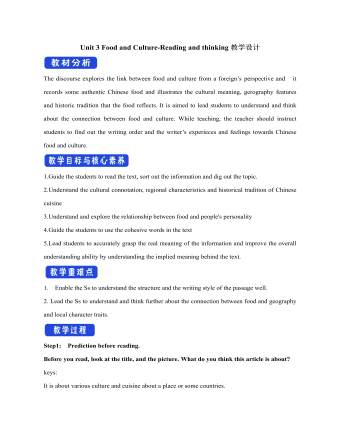
新人教版高中英语选修2Unit 3 Food and Culture-Reading and thinking教学设计
The discourse explores the link between food and culture from a foreign’s perspective and it records some authentic Chinese food and illustrates the cultural meaning, gerography features and historic tradition that the food reflects. It is aimed to lead students to understand and think about the connection between food and culture. While teaching, the teacher should instruct students to find out the writing order and the writer’s experieces and feelings towards Chinese food and culture.1.Guide the students to read the text, sort out the information and dig out the topic.2.Understand the cultural connotation, regional characteristics and historical tradition of Chinese cuisine3.Understand and explore the relationship between food and people's personality4.Guide the students to use the cohesive words in the text5.Lead students to accurately grasp the real meaning of the information and improve the overall understanding ability by understanding the implied meaning behind the text.1. Enable the Ss to understand the structure and the writing style of the passage well.2. Lead the Ss to understand and think further about the connection between food and geography and local character traits.Step1: Prediction before reading. Before you read, look at the title, and the picture. What do you think this article is about?keys:It is about various culture and cuisine about a place or some countries.
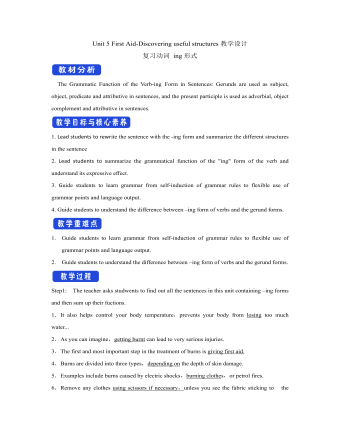
新人教版高中英语选修2Unit 5 First Aid-Discovering useful structures教学设计
You have no excuse for not going.你没有理由不去。He was punished for not having finished his homework.他因未完成作业而受到惩罚。2.动词ing形式复合结构由物主代词或人称代词宾格、名词所有格或普通格加动词ing,即“sb./sb.'s+doing”构成。动词ing形式的复合结构实际上是给动词ing形式加了一个逻辑主语。动词ing形式的复合结构有四种形式:①形容词性物主代词+动词ing②名词所有格+动词ing③代词宾格+动词ing④名词+动词ingHer coming to help encouraged all of us.她来帮忙鼓舞了我们所有人。The baby was made awake by the door suddenly shutting.这个婴儿被突然的关门声吵醒了。Can you imagine him/Jack cooking at home?你能想象他/杰克在家做饭的样子吗?无生命名词无论是作主语还是作宾语都不能用第②种形式。Tom's winning first prize last year impressed me a lot.汤姆去年得了一等奖使我印象深刻。Do you mind my/me/Jack's/Jack leaving now?你介意我/杰克现在离开吗?Excuse me for my not coming on time.很抱歉我没能按时来。His father's being ill made him worried.他父亲病了,他很担心。We are looking forward to the singer's/the singer to give us a concert.我们盼望着这位歌手来给我们举办一场演唱会。
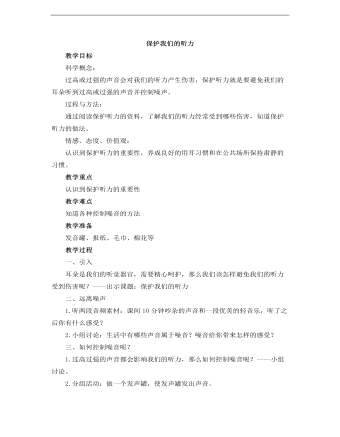
小学科学教科版四年级上册《保护我们的听力》教案
过程与方法:通过阅读保护听力的资料,了解我们的听力经常受到哪些伤害,知道保护听力的做法。情感、态度、价值观:认识到保护听力的重要性,养成良好的用耳习惯和在公共场所保持肃静的习惯。教学重点认识到保护听力的重要性教学难点知道各种控制噪音的方法教学准备发音罐、报纸、毛巾、棉花等
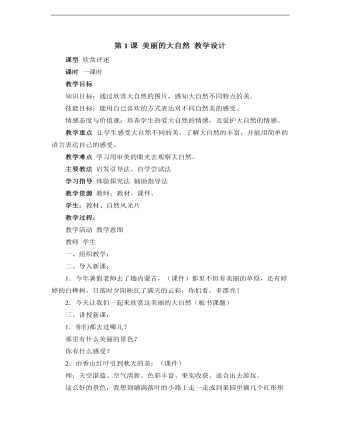
小学美术桂美版一年级上册《第1课美丽的大自然》教学设计说课稿
教学目标 知识目标:通过欣赏大自然的图片,感知大自然不同特点的美。 技能目标:能用自己喜欢的方式表达对不同自然美的感受。 情感态度与价值观:培养学生热爱大自然的情感,及爱护大自然的情感。 教学重点让学生感受大自然不同的美,了解大自然的丰富,并能用简单的语言表达自己的感受。 教学难点学习用审美的眼光去观察大自然。 主要教法启发引导法、自学尝试法 学习指导体验探究法辅助指导法 教学资源教师:教材、课件。 学生:教材、自然风光片 教学过程: 教学活动教学意图 教师学生
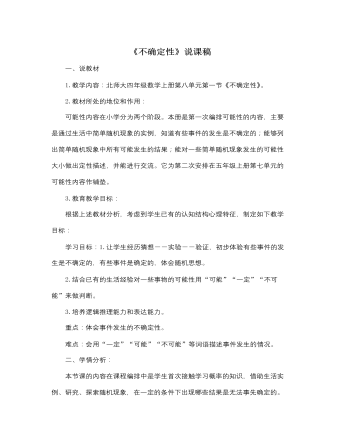
北师大版小学数学四年级上册《不确定性》说课稿
在教学学习新知一时,通过让学生动手掷硬币活动,使学生先猜想再验证,学生就会明白在掷硬币时,可能正面朝上,也可能反面朝上,哪面朝上具有不确定性。再通过对三个问题的分析,结果分别有几种不同情况,最后确定可能性。通过对日常生活中不同事件的分析,学生就会得出许多事件的结果是不可预知的,具有不确定性。学习新知一通过设计一系列问题引导学生对不确定性问题的理解和掌握。学习新知二通过先让学生分析、讨论交流,再连一连,就知道第(1)个盒子摸到的结果只有一种情况,一定是黄球;第(2)个盒子摸到的结果也只有一种情况,一定是白球,所以不可能是黄球;第(3)个盒子摸到的结果有两种情况,可能是黄球,也可能是白球,所以只能连“可能是黄球”,这样学生就会用“一定”“可能”“不可能”等词语描述事件发生的情况。
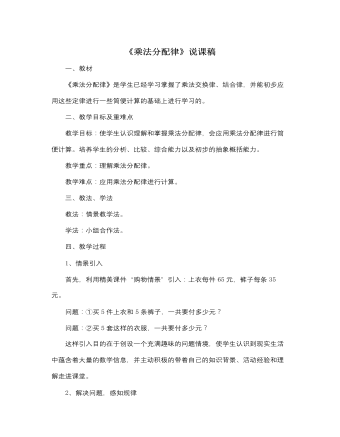
北师大版小学数学四年级上册《乘法分配律》说课稿
四、教学过程1、情景引入首先,利用精美课件“购物情景”引入:上衣每件65元,裤子每条35元。问题:①买5件上衣和5条裤子,一共要付多少元?问题:②买5套这样的衣服,一共要付多少元?这样引入目的在于创设一个充满趣味的问题情境,使学生认识到现实生活中蕴含着大量的数学信息,并主动积极的带着自己的知识背景、活动经验和理解走进课堂。2、解决问题,感知规律(1)让学生合作完成,男同学解答问题①得到65×5+35×5=500(元)。女同学解答问题②得到(65+35)×5=500(元)(2)通过分析,两个问题实际上是一样的,两个算式应该相等。即:65×5+35×5=(65+35)×5。(3)新课标强调要让学生经历、体验知识获得的过程,主动参与探索,从而发现规律。在学生独立解答的过程中,我会重点引导学生感悟问题①和问题②的共同特征:买了同样的衣服,体会规律形成的过程。3、检验规律,建立模型

北师大版小学数学四年级上册《加法结合律》说课稿
学生虽然在此前的学习中,对四则运算中的一些性质和规律有感性的认识,但加法结合律毕竟是属于理性的总结和概括,比较抽象,学生不易理解和掌握。因此,教师在教学过程中,要利用学生已经掌握的知识,让学生独立解答,然后引导学生分析、比较不同的方法,并通过自己的举例发现规律,概括出相应的运算律。根据以上教材内容和结构的分析,考虑到学生已有的心理结构特征,我确定了如下教学目标:1、理解并掌握加法结合律,并能够用字母来表示加法结合律。2、经历探索加法结合律的过程,通过对熟悉的实际问题的解决,进行比较和分析,发现并概括出运算定律。3、在具体情境中体会应用加法结合律进行简便计算的实际意义,感受到加法结合律的价值,与日常生活的密切联系,形成一定得应用意识。重点:理解并掌握加法结合律,能用字母来表示加法结合律。难点:经历探索加法结合律的过程,发现并概括出运算定律。
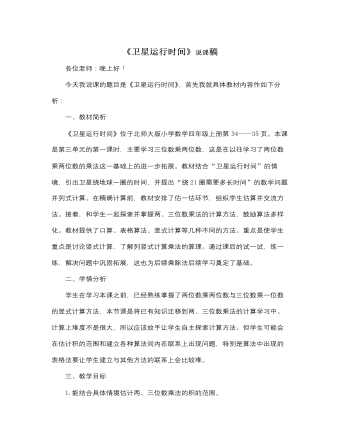
北师大版小学数学四年级上册《卫星运行时间》说课稿
二、学情分析学生在学习本课之前,已经熟练掌握了两位数乘两位数与三位数乘一位数的竖式计算方法,本节课是将已有知识迁移到两、三位数乘法的计算学习中。计算上难度不是很大,所以应该放手让学生自主探索计算方法。但学生可能会在估计积的范围和建立各种算法间内在联系上出现问题,特别是算法中出现的表格法要让学生建立与其他方法的联系上会比较难。三、教学目标1.能结合具体情境估计两、三位数乘法的积的范围。2.探索两、三位数乘法的计算方法,能正确计算,并乐于与同伴交流算法。3.培养计算兴趣和良好的计算习惯,提高利用乘法运算解决实际问题能力。三、教材处理在理解尊重教材的基础上,适当整合并创造性使用教材:1、在情境创设中加入翟志刚的视频图片。2、变基础练习试一试“先估后算“为”先算后估“。【课件出示】
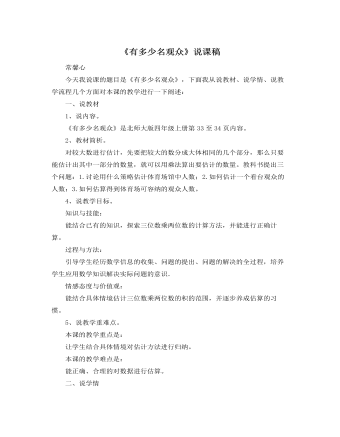
北师大版小学数学四年级上册《有多少名观众》说课稿
今天我说课的题目是《有多少名观众》,下面我从说教材、说学情、说教学流程几个方面对本课的教学进行一下阐述:一、说教材1、说内容。《有多少名观众》是北师大版四年级上册第33至34页内容。2、教材简析。对较大数进行估计,先要把较大的数分成大体相同的几个部分,那么只要能估计出其中一部分的数量,就可以用乘法算出要估计的数量。教科书提出三个问题:1.讨论用什么策略估计体育场馆中人数;2.如何估计一个看台观众的人数;3.如何估算得到体育场可容纳的观众人数。4、说教学目标。知识与技能:能结合已有的知识,探索三位数乘两位数的计算方法,并能进行正确计算。过程与方法:引导学生经历数学信息的收集、问题的提出、问题的解决的全过程,培养学生应用数学知识解决实际问题的意识.
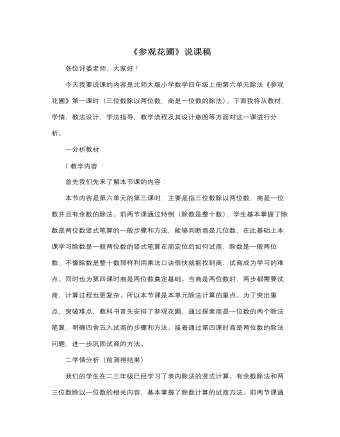
北师大版小学数学四年级上册《参观花圃》说课稿
二学情分析(前测得结果)我们的学生在二三年级已经学习了表内除法的竖式计算、有余数除法和两三位数除以一位数的相关内容,基本掌握了除数计算的试商方法。前两节课通过特例(除数是整十数),学生基本掌握了除数是两位数竖式笔算的一般步骤和方法,能够判断商是几位数。三教学目标基于我对教材的分析和学情的分析我确定了以下教学目标:1、知识与技能:会用“四舍五入”法把除数看作整十数试商。2、过程与方法:能正确计算三位数除以两位数,商是一位数的除法。3、情感态度价值观:经历用乘法估商的过程,归纳概括三位数除以两位数的试商方法,进一步发展学生的估计意识。四、重点难点本节课的重点是:能用四舍五入法把除数看作整十数进行试商,正确计算三位数除以两位数的除法。难点:用乘法估商的过程,归纳概括三位数除以两位数的试商方法。
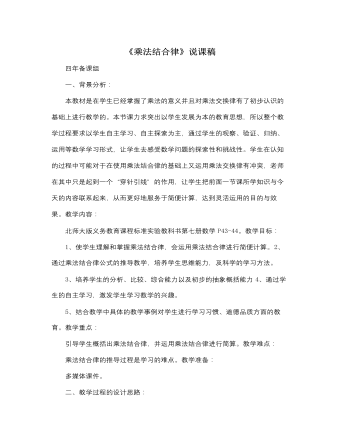
北师大版小学数学四年级上册《乘法结合律》说课稿
当然独立思考是合作的前提,没有独立思考的合作交流是空的,在本教学中也有体现,例如在进行猜想验证的教学环节中,我要求每个学生自己先写一个式子,再四人小组进行交流,最后全班进行交流。在总结出乘法结合律的规律时,要求学生用自己的语言叙述概括,用自己的方法把这个规律记住。充分发挥学生的想象力,以就能获得学生创新的思维火花,同时体现“主动参与、积极思考、合作发现、体验成功、健康发展”的教学思路。在巩固练习阶段,充分给学生以自主权,学生以“创造”的空间,并通过比较,感受计算方法的灵活多样,培养学生灵活运用知识进行解题的能力。在练习的设计上,设计了有层次的练习题,使学有余力的学生在原有的基础上有所提高,体现了因材施教的思想,落实了“人人学有价值的数学”、“人人都能获得必要的数学”、“不同的人在数学上得到不同的发展”基本教学理念。
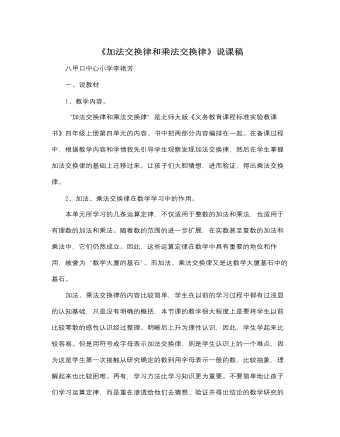
北师大版小学数学四年级上册《加法交换律和乘法交换律》说课稿
1、教学内容。“加法交换律和乘法交换律”是北师大版《义务教育课程标准实验教课书》四年级上册第四单元的内容。书中把两部分内容编排在一起。在备课过程中,根据教学内容和学情我先引导学生观察发现加法交换律,然后在学生掌握加法交换律的基础上迁移过来。让孩子们大胆猜想,进而验证,得出乘法交换律。2、加法、乘法交换律在数学学习中的作用。本单元所学习的几条运算定律,不仅适用于整数的加法和乘法,也适用于有理数的加法和乘法。随着数的范围的进一步扩展,在实数甚至复数的加法和乘法中,它们仍然成立。因此,这些运算定律在数学中具有重要的地位和作用,被誉为“数学大厦的基石”。而加法、乘法交换律又是这数学大厦基石中的基石。